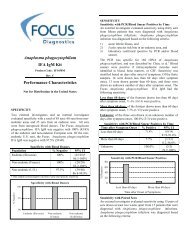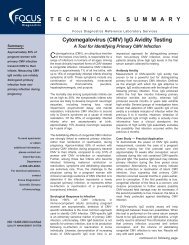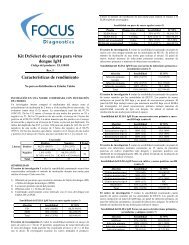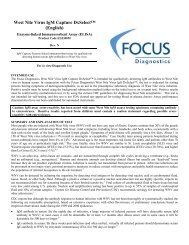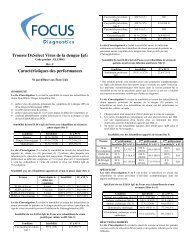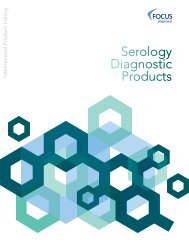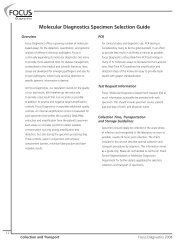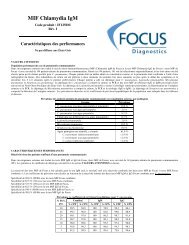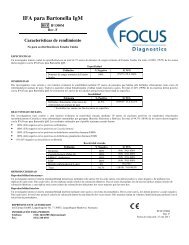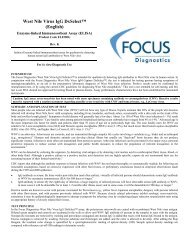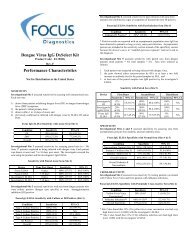Epstein-Barr Virus VCA IFA IgG (English) - Focus Diagnostics
Epstein-Barr Virus VCA IFA IgG (English) - Focus Diagnostics
Epstein-Barr Virus VCA IFA IgG (English) - Focus Diagnostics
You also want an ePaper? Increase the reach of your titles
YUMPU automatically turns print PDFs into web optimized ePapers that Google loves.
FOCUS <strong>Diagnostics</strong><br />
10. Humid chamber for incubation of slides<br />
11. Distilled or purified water<br />
12. Timer<br />
13. Absorbant paper for blotting slides<br />
14. Fluorescence microscope, recommended parameters<br />
Excitation Filter 470–490nm<br />
<strong>Barr</strong>ier Filter 520–560nm<br />
Light Source HBO 100W, mercury<br />
Objective 20–40X, fluorescence quality, high dry<br />
SHELF LIFE AND HANDLING<br />
1. Kits are stable through the end of the month indicated in the expiration<br />
date when stored at 2 to 8°C.<br />
2. Do not use test kit or reagents beyond their expiration dates.<br />
3. Do not expose reagents to strong light during storage or incubation.<br />
WARNINGS AND PRECAUTIONS:<br />
1. This kit is for in vitro diagnostic use only.<br />
2. All blood products should be treated as potentially infectious. Source<br />
materials from which this product (including controls) was derived have<br />
been screened for Hepatitis B surface antigen, Hepatitis C antibody and<br />
HIV-1/2 (AIDS) antibody by FDA-approved methods and found to be<br />
negative. However, as no known test methods can offer 100% assurance<br />
that products derived from human blood will not transmit these or other<br />
infectious agents, all controls, serum specimens and equipment coming<br />
into contact with these specimens should be considered potentially<br />
infectious and decontaminated or disposed of using proper biohazard<br />
precautions.<br />
3. Evan's Blue is a carcinogen. Avoid contact with skin or eyes.<br />
4. Do not substitute or mix reagents from different kit lots or from other<br />
manufacturers.<br />
5. Use only protocols described in this insert. Incubation times or<br />
temperatures other than those specified may give erroneous results.<br />
6. Cross-contamination of patient specimens on a slide can cause erroneous<br />
results. Add patient specimens and handle slides carefully to avoid<br />
mixing of sera from adjoining wells.<br />
7. Bacterial contamination of serum specimens or reagents can produce<br />
erroneous results. Use aseptic techniques to avoid microbial<br />
contamination.<br />
8. Mounting Medium contains 30 to 60 % glycerol which may cause<br />
irritation upon inhalation or skin contact. Upon inhalation or contact,<br />
first aid measures should be taken.<br />
SPECIMEN COLLECTION AND PREPARATION<br />
Serum is the preferred specimen source. No attempt has been made to assess<br />
the assay's compatibility with other specimens. Hyperlipemic, hemolyzed, or<br />
contaminated sera may cause erroneous results; therefore, their use should be<br />
avoided.<br />
Specimen Collection and Handling<br />
Collect blood samples aseptically using approved venipuncture<br />
techniques by qualified personnel. Allow blood samples to clot at room<br />
temperature prior to centrifugation. Aseptically transfer serum to a<br />
tightly closing sterile container for storage at 2 to 8°C. If testing is to be<br />
delayed longer than 5 days, the sample should be frozen at –20°C or<br />
colder. Freeze-thaw damage can result if specimens are frozen in selfdefrosting<br />
freezers. Thaw and mix samples well prior to use.<br />
Specimen Preparation<br />
Prepare 1:10 screening dilutions of patient sera as follows:<br />
mix 10 µL of patient serum with 90 µL PBS in microcentrifuge tubes<br />
or a microtiter plate.<br />
Where it is necessary to determine endpoint titers, dilute the screening<br />
dilution serially with PBS.<br />
TEST PROCEDURE<br />
1. Remove slides from cold storage. To avoid condensation, allow slides<br />
to reach room temperature before opening slide packets.<br />
2. Apply 15 µL of Positive Control, as bottled, to the appropriate slide<br />
well. Use PBS to serially dilute the Positive Control 16-fold beyond the<br />
EBV <strong>VCA</strong> <strong>IFA</strong> <strong>IgG</strong><br />
Page 2<br />
bottled dilution. Apply 15 µL of each serial dilution to an appropriate<br />
slide well.<br />
3. Apply 15 µL of EBV Negative Control, as bottled, to the appropriate<br />
well. Do not dilute the Negative Control.<br />
4. For each patient sample to be tested, add approximately 15 µL of the<br />
prepared sample dilutions (see Specimen Preparation, above) to an<br />
appropriate slide well. Make notations to later identify each well when<br />
reading the results.<br />
5. Incubate slide(s) in a humid chamber for 30 ± 2 minutes at 35 to 37°C.<br />
6. Remove slides from the humid chamber and gently rinse each slide with<br />
a stream of PBS. Do not aim the stream of PBS directly at the slide<br />
wells. Rinse one row at a time to avoid mixing of specimens. Wash<br />
slides by submersing the rinsed slides into Coplin or slide staining jars<br />
containing PBS for 10 minutes.<br />
7. Dip the washed slides briefly in distilled or purified water, and allow the<br />
slides to air dry.<br />
8. Add approximately 15 µL <strong>IgG</strong> Conjugate to each slide well.<br />
9. Incubate slides in a humid chamber for 30 ± 2 minutes at 35 to 37°C.<br />
10. Repeat wash steps 6 and 7.<br />
11. Place a few drops of Mounting Medium on the slide and cover with a<br />
24 x 50mm coverslip. Remove any air bubbles and excess Mounting<br />
Medium with absorbant paper.<br />
12. View wells at a final magnification of 200X on a properly equipped<br />
fluorescence microscope. For optimum fluorescence, read slides the<br />
same day the assay is performed. If this is not possible, store in the dark<br />
at 2 to 8°C up to 24 hours.<br />
QUALITY CONTROL<br />
Each run (each time a slide, or group of slides, is processed) should include<br />
both Positive and Negative controls.<br />
1. The Positive Control should endpoint (1+fluorescence) at 8 fold beyond<br />
the bottled dilution. However, due to differing laboratory conditions,<br />
including equipment, the endpoint may range from 4 to 16 fold beyond<br />
the bottled dilution.<br />
2. The Negative Control should be negative at the bottled dilution. All of<br />
the cells should appear pale green to red in color.<br />
If controls do not exhibit these results, patient test results should be<br />
considered invalid and the assay repeated.<br />
INTERPRETATION OF TEST RESULTS<br />
Microscope optics, light source condition and type will determine overall<br />
fluorescent intensity and endpoint titers. Read control wells first during every<br />
run to ensure correct interpretation.<br />
Reading the Slides<br />
Read the fluorescent intensity of lymphocytes on each well, and grade<br />
the fluorescence as follows:<br />
2 to 4+: Moderate to intense apple-green fluorescence of 10 to 15% of<br />
lymphocytes.<br />
1+: Definite, but dim fluorescence equivalent to that observed for<br />
the Positive Control at its reference endpoint titer.<br />
Negative: No fluorescence or fluorescence equal to that observed in the<br />
Negative Control well.<br />
Interpreting the Patient Specimen Results<br />
The reciprocal of the highest serum dilution that exhibits definite (1+)<br />
apple-green fluorescence in 10 to 15% of the cells is termed the serum<br />
endpoint titer.<br />
≥ 1:10 <strong>VCA</strong> <strong>IgG</strong> endpoint titers of 1:10 and greater are indicative of<br />
EBV infection at an undetermined time. Such persons are<br />
immune to contracting infectious mononucleosis. To determine<br />
whether the detected infection is recent or past in nature,<br />
correlate results with EBV <strong>VCA</strong> IgM and EBNA antibody titers.<br />
< 1:10 <strong>VCA</strong> <strong>IgG</strong> endpoint titers less than 1:10 suggest that the patient<br />
has neither recent nor past EBV infection. Such persons are<br />
susceptible to infectious mononucleosis.



